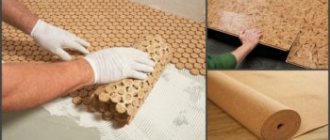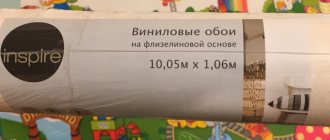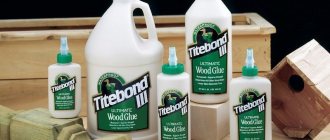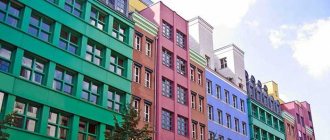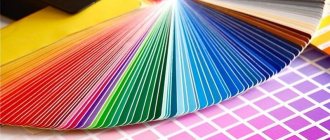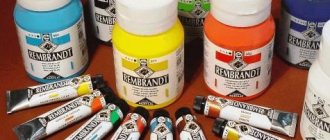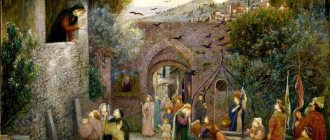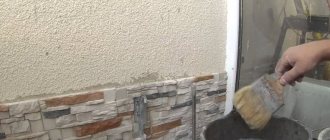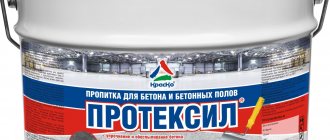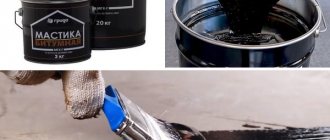Gouache is a dense and opaque texture paint, a type of water-soluble adhesive. When the gouache dries, the surface on which the gouache was applied becomes velvety and matte. Gouache allows you to work on various materials, be it paper or cardboard, plywood or canvas.
Initially, the word “gouache” itself appeared in the 18th century in France. However, back in the Middle Ages, the process of creating and producing this paint already existed in Europe. Many miniatures in books published at that time were made in gouache. Gouache was widely used by artists during the Renaissance.
It was with gouache that many sketches and various sketches were made by various artists; a lot of preparatory work was done with gouache for the most significant works of fine art; portrait miniatures were also made in this technique.
The period that covers the last years of the end of the 19th century - the beginning of the 20th century is considered to be the heyday of the use of gouache technique in the fine arts.
Artists in Russia, members of the World of Art association, used gouache to paint easel works of grandiose scale. This technique was used to create many sketches of theatrical costumes for actors, as well as sketches of various sets for plays and productions. They also used gouache to make various posters.
Many great masters of the past, such as the famous Flemings Rubens and Van Dyck, the German painter Durer, used the gouache technique in their work. Gouache also enjoyed deserved interest among artists of a later period (Picasso, Henry Moore, etc.).
What is gouache: composition
These paints are water soluble. Unlike watercolors, they have a thick base.
Gouache paints consist of ground pigments and white. Thanks to this, they get some muted colors. Also, after drying, the drawings become lighter - they become whitened. But they acquire a delicate velvety and matte finish.
Additionally, they contain binding components such as dextrin, gum arabic, and starch. Some add acrylic, oil, honey, glycerin, and fruit gum.
How is it different from watercolor?
It is important for artists to understand the difference between gouache and watercolor and how to use it correctly. Outwardly it looks like watercolor. But its characteristics are more similar to oil or acrylic paint.
Gouache is also produced on the basis of water, but it has different characteristics from watercolors. What is also different is that you can paint on suitable surfaces with paints. Gouache involves applying light tones to dark strokes; several layers are allowed. That is, the difference lies in density: watercolor is light and watery, while the texture of gouache is quite dense.
go to top
Types of gouache
This paint is widely used today. However, professional artists rarely paint serious works with it, since it is prone to cracking (that is, short-lived) and fading.
Artistic gouache is considered professional. These are sets of 36 colors. This paint contains gum arabic, thanks to which it has high covering power and is velvety and matte.
Poster gouache is used for decorative purposes. It is used to draw posters, decorations, and design stands. Thanks to kaolin, which replaces regular white, gouache dries faster, is brighter, and is less susceptible to fading and exposure to air humidity. They work with paint on cardboard, wood, canvas, plywood. The second name for poster gouache is children's. This is the type most often used by beginning artists.
Many people know what fluorescent gouache is. It glows when exposed to ultraviolet light. This happens due to the presence of special pigments in the composition. Typically these are phosphors based on organic resins. In addition, it contains an antiseptic, PVA glue and plasticizers.
Neon paints are a type of fluorescent gouache. They have the unique ability to glow even in the dark.
Acrylic gouache is less common than other varieties. It contains acrylates, which enhance the brightness of paints, grip and resistance to damage. The works practically do not fade in the sun and do not wash out when exposed to moisture.
How to choose?
To enjoy drawing and get the desired result, you need to read the recommendations of experts on how to choose gouache. When choosing, you need to consider many parameters. And the best gouache for painting is paint labeled “children’s”; it has optimal thickness and texture.
What is important to pay attention to:
- type of packaging: cardboard or plastic;
- what surfaces is gouache designed for?
- the need to prepare the surface before painting - in this case, acrylic gouache is optimal.
The number of colors should be chosen based on the age of the baby and his needs. For the little ones, a set of 6 colors is enough; for schoolchildren, sets of 10-12 colors are suitable. Art studio students will need expanded sets.
Properties of gouache
It has significant advantages when comparing it with other types of paints:
- Due to its denser consistency, the paint does not spread over the surface of materials. This also reduces the absorption of the gouache. Therefore, designs can be applied to a variety of surfaces. These can be paper, the human body, fabrics, glass, ceramics, wood, metal, stones, walls, ceilings and so on.
- Gouache dissolves with water. Therefore, it is easy to restore after drying. Paint on smooth surfaces can be easily washed off with plain water without the use of chemicals. It is because of this property that special designs are used at holidays, such as painting on windows or ceramic tiles. At the end of the event, the paint is washed off.
- Gouache has good covering power. Because of this, it is quite easy to correct errors in the work by simply painting over the error. Even light gouache perfectly paints over any inaccuracies, including completely dark ones.
- The paint is odorless.
- Gouache paintings dry quickly.
- If it gets on your body or clothing, it can be easily washed off.
- Gouache is harmless to the body if it does not get into the eyes. Of course, it is not recommended to eat it.
- The price of this material is low, so it is accessible to almost all people.
Surfaces for the basis of the drawing
With gouache you can create real masterpieces on almost any canvas and material, the main thing is that it is dense.
Paper
It is recommended that beginners make the easiest drawings on paper. You should choose A3 paper or A4 paper, but with increased density. Whatman paper is smooth, the paint adheres to it perfectly, and the base does not get wet. If the paper is thin, it will immediately begin to warp if it gets hit with gouache.
A good option for creating a picture is cardboard. It should be white and uniform in texture. In some cases (depending on the specifics of the design), the use of colored or tinted cardboard is allowed. Corrugated cardboard and gouache, on the contrary, are incompatible - the base becomes deformed over time.
Plywood
Working with gouache on plywood is a pleasure. This material will never get wet if it has a high quality and smooth finish. There should be no stains on the plywood that can appear even from under a layer of paint.
Glass
Gouache can also be used to work with glass. Usually it is used to paint glasses, plates, stained glass windows, and crafts. It is recommended to first make a sketch in pencil on a regular sheet of paper, then transfer it to glass using carbon paper. Afterwards you can apply paint.
Unfortunately, the water base of gouache does not allow you to preserve drawings on glass for a long time. But this can be a big plus, because you can draw new pictures every time - for example, make drawings for the New Year on window glass. The child will enjoy realizing his ideas by easily adjusting the details with a damp cloth. Gouache fits well on glass bottles - it doesn’t flow and dries quickly. The top of the finished product can be varnished.
Textile
Fashionable prints on T-shirts, skirts and trousers are now at the peak of popularity. Craftswomen who make curtains and products for children also draw on fabric. Of course, an ordinary gouache drawing on fabric will not last long, unless handled with care. Contact with water and washing will completely remove the paint. Therefore, to fix the print, varnish or glue is introduced into the paint, or the finished design is coated with a special varnish for fabric. If you plan to wash such a thing, it is better to use special acrylic colors rather than gouache.
Restoring dried gouache
Often the paint becomes rock hard. Naturally, it is impossible to draw with it. But don’t immediately throw away the jar of dried gouache.
To restore the properties of the paint, you need to use hot water. A little boiling water is poured into the gouache and they try to stir the contents. You can work with a knife, carefully cutting the paint into pieces, crushing them.
You can place a closed jar near the radiator for a while if it is hot. Then the contents are thoroughly stirred again. Add hot water if necessary.
When the composition becomes homogeneous, resembling sour cream in consistency, it is ready for use.
History of painting
The art of gouache took its initial steps during the times of medieval book miniatures. Painters from Asia and Europe created extraordinary illustrations by adding whitewash to watercolors.
1 / 3
The Renaissance is characterized by the use of gouache in the creation of frescoes and sketches of paintings. In the 16th-17th centuries, portrait art began to develop. This led to the fact that miniature portraits were painted with it on various materials.
1 / 3
In the 18th-19th centuries, combining gouache with watercolor, the authors of paintings ensured that their works looked realistic and expressive. In the middle of the 19th century, factory gouache began to be actively produced. It is at this time that gouache paints acquire their basic properties: thickness, dullness, etc.
1 / 3
At the end of the 19th and beginning of the 20th centuries, great painters actively worked with gouache, using it to create full-fledged works of art. In Russia, the gouache technique reaches a high level of development. During this period, gouache paintings by famous artists such as V.A. Serov, A.Ya. Golovin, A.Ya. Benois and others appeared.
Ways to improve the properties of gouache
It is known that this paint is not as bright as others. To increase color saturation and reduce dullness, you can use sugar water.
There is no need to pour the sweet syrup directly into the paint jar. The sugar will set over time. It will be impossible to restore such a composition. It is better to prepare the sweet water separately and dip it in the syrup before dipping the brush into the paint.
To make the colors in the picture more bright and shiny rather than dull, two tablespoons of granulated sugar are dissolved in half a glass of water.
When working on wood or plywood, it is necessary to reduce paint absorption into the surface. Then PVA glue or paste is added to the gouache. This makes it stronger and does not leave marks on your hands. This paint is smooth to the touch and shiny.
Tips for beginning artists
When choosing the best gouache for an artist, it is worth studying the selection presented, the composition of paints and their characteristics. Initially, you need to purchase the necessary materials: paper, a box of paints, brushes, a palette, pencils. Minimum sets include 12 shades that can be mixed to achieve the desired shades.
Some artists may purchase a variety of tools, such as a palette knife for mixing leftover paint onto the canvas.
Initially, it is recommended to start drawing simple objects (mountains, trees, landscapes). You can start drawing still lifes if you have certain skills and experience. To avoid mistakes, it is important to first draw sketches with a simple pencil.
go to top
Making gouache at home
This creative material is not very expensive in the store. Therefore, making it at home is not always a wise decision. But sometimes you urgently need to paint something in gouache, but the store is already closed. For example, your baby suddenly really wanted to create a picture. Then you will need to know how to make gouache with your own hands.
There is a chalk paint option. It requires regular chalk, water and a coloring pigment.
- The chalk is finely crushed.
- The powder is poured into a jar.
- Pigment is added.
- Dilute the mixture with water.
The second method is simpler. Instead of chalk, use white toothpaste. Pigment is added to it and stirred.
You can additionally add PVA glue to make the paint brighter.
The third method is identical to the second, but the toothpaste is replaced with shaving foam.
The fourth recipe uses flour (half a kilo), salt (2 tablespoons), vegetable oil (2 tablespoons) and water. All this is mixed with a mixer. Add water little by little until the mixture reaches the desired consistency.
The base is poured into jars. Pigment is already added to them. Then the homemade gouache is thoroughly mixed.
You can use food coloring, poster ink, printer ink, or ink as a pigment. Powdered watercolor will also work.
Watercolor paint
Most of us have a lot of experience with watercolor paints, as we all used them as children. Stop by your local dollar store and get a pallet for 99 cents!
This is really cool considering watercolor has been used for centuries (think Egyptian times) and now you'll see entire preschool classes creating their own little masterpieces with watercolor paint.
Watercolor paint is inexpensive but can produce a beautiful end result. It dries quickly, is almost transparent and has a matte finish. Artists can layer watercolor paint because of its translucency to create a more vibrant image.
However, watercolor paints require a special type of paper as the base is water, so it is important that the paper does not absorb moisture. Watercolor can easily bleed through something like printer paper because it is very absorbent.
A silly but great example of letting your child use watercolors on the pages of a coloring book. The moment the brush touches the page, the color will disappear and there will be almost no color showing on the page.
On the other hand, as an artist you control the color outcome when painting with watercolors. If you add more water, the color will become almost translucent. If you use a small amount of water, the color will be deeper.
Imagine this:
You've completed your watercolor masterpiece and a single drop of water has landed on the page. Instantly your work changes.
Watercolors may be cheap to buy and seem like one of the easiest types of paint to use, but they can actually be difficult to master. Finding the perfect ratio of water to paint takes some work and effort. It is also much more difficult to hide a mistake when using watercolor paint due to its opacity.
First drawing experiences
It is advisable to offer water-soluble paints to children, as they are harmless. However, there are nuances that can cause inconvenience. These are stained tables, spilled water, merging of parts due to too much liquid on the brush.
It is easier for beginning artists to work with gouache. Children can paint with such paints as early as 2-3 years old. Before starting work, you should explain to your child that the gouache must dry, otherwise it may flow from one part to another and change color. Therefore, you should not paint with paint of a different color next to a still wet part.
Usually, the first work of children is to color objects along the contours drawn on paper. But it is permissible to paint according to the plan directly with brushes.
Color palette
When choosing which gouache is best to paint, you can consider a color palette that includes dozens of shades, fluorescent types or with glitter. Artistic gouache contains the names of colors according to GOST, so that the artist understands exactly what shade he will get in the end.
Because of the possibility of creating a dense coating, painting begins with dark shades. The artist can arrange highlights because different colors mix well. To prevent dirt, it is important to mix shades that are nearby on the color wheel. Thanks to shading, the play of light and the absence of sharp boundaries are ensured.
go to top
Life hacks when working with gouache
Not all parents are happy when their kids express a desire to paint. This is easy to understand. Gouache spilled on a table or clothes can ruin the mood of a mother and a young artist for a long time. To prevent this from happening, it is enough to dilute the paint with water in advance to the desired consistency. The jars themselves can be glued to small plywood. Then they will not tip over and spill.
Often the child spoils the paints by mixing colors and not rinsing the brushes sufficiently. This will not happen if you give him different brushes for each color, marking them with markers. Then the child will no longer need water, which means he will not be able to spill it on the floor, table or clothes.
All these life hacks will help you avoid troubles while painting with paints.
Gouache: work on a colored background
This option is great for drawings depicting the underwater world, the sky with clouds and birds flying across it. The easiest way to paint winter is with gouache. To do this, snowflake dots, Christmas trees and other objects are applied to blue or blue cardboard. You can use several colors or just one while drawing.
To complete the winter landscape you will only need white gouache. It represents snow, clouds, trees. You should not achieve complete uniform painting of objects with white. Some poorly painted areas add realism to the picture. They play the role of shadows.
